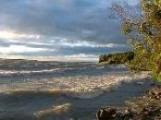Lake Simcoe can be like a temperamental child — serene and peaceful one minute, only to turn surly as winds whip it into a fury.
And when that baby gets angry, there’s no calming it down.
“This lake is so expansive, and it’s shallow so it can really blow up fast,” says Sgt. Bob Eeles of the South Simcoe Police as he steers the marine unit’s 26-foot Harbercraft into Cook’s Bay.
South Simcoe launched the unit, which includes six officers, the Harbercraft and two Sea-Doos donated St. Onge Recreation, last Friday.
Officers started by patrolling the waters and reminding boaters to have all their safety gear, including life jackets, in place for another busy boating season.
Being prepared before you head out onto Lake Simcoe can make a difference if weather suddenly changes for the worse.
Even the officers can find themselves in peril if a storm suddenly approaches.Const. John Ellis remembers when a fellow officer called to warn that tornado-like weather pelting down heavy rains at Highway 400 was headed his way.
“They radioed me to let me know to get into shore because of the heavy weather,” Ellis says. “But it got there so quick I didn’t even have time to make it in.”
Luckily, Ellis was close enough to shore to weather the storm.
But boaters suddenly caught in the middle of storm, may not be so lucky. That’s why South Simcoe is reminding them to make sure their vessels are ship shape before heading out onto the lake this year.
During a short-patrol Friday, police discovered a boater who was doing just that.
“I’m just out here for a little bit checking to make sure our GPS (global positioning system) is in good working order,” the boat’s owner told Eeles as the Harbercraft pulled up alongside of the cabin cruiser.
When boaters are in distress, the South Simcoe marine unit, along with units from the OPP, York Regional Police and Barrie Police put their training, equipment and technology into action.When it comes to rescues, technology has helped police track down boats on Ontario’s fifth largest lake.
The Harbercraft is equipped with GPS and radar that helps officers pinpoint their own location and the whereabouts of other boats.
“The radar is sensitive enough to pick up birds that are on the water,” Const. Ellis says. “We can be in complete darkness or fog and find boats.”
Boaters with their own GPS and a VHS radio or cell phone can give police their co-ordinates, greatly reducing the time it takes to find them.
It’s the smaller craft without equipment that pose the biggest problem for rescuers
“They go out with no life jackets or equipment and they can get into serious trouble,” Eeles says.
Police from South Simcoe, the OPP and the Canadian Coast Guard had to rescue three 12-year-old kayakers who drifted far out into the lake while trying to paddle from Innisfil Beach Park to Snake Island May 18. Fortunately, they had the foresight to wear life jackets.
Even swimmers on floatation devices such as air mattresses can suddenly find themselves too far from shore to get back.
“Usually it’s cottagers who call us and tell us there’s someone way out in the middle of the lake,” Eeles says.
Drinking and boating is another focus for the marine unit. But judging from last year, there appears to be some good news in that area.
“Most boaters are fairly responsible in that regard,” Eeles says. “Even when you have all your faculties, it can get difficult out here. People want to protect their investments. They’re driving expensive boats.”
Marine police carry alcohol-screening devices just like officers on the road.Under a law passed last year, boaters caught drinking and boating in Ontario face the same penalties as those caught drinking and driving.
“It’s all tied directly to your driver’s license now,” Eeles says, adding the law has acted as great deterrent for boaters.South Simcoe Police offer the following safety tips:• File a boating plan with a marina, friend or family member, so youcan be located quickly and efficiently should you run into difficulties. • Know the condition of the water before you go out and take intoconsideration changing weather conditions that deteriorates rapidlyand may have an effect on water conditions. • Always know where your children are when around water; never leavechildren unattended. • Don’t fool yourself into thinking that your child would never go nearthe water without permission. Children react quickly to things andoften don’t recognize possible consequences. • Wear life jackets at all times. • Carry a cell phone to reach police in case of an emergency. Police boats are available to respond to emergencies at any time of the day or night. •Wear proper floatation attire and clothing when participating in a water-related activity. • Ensure that equipment and safety devices are in good working order,including having enough fuel, prior to venturing out onto the water.



